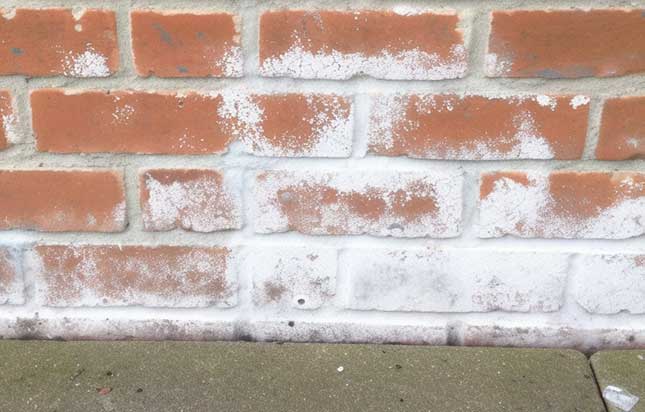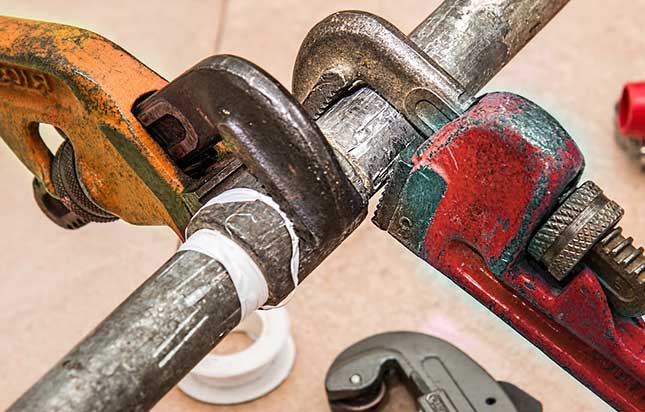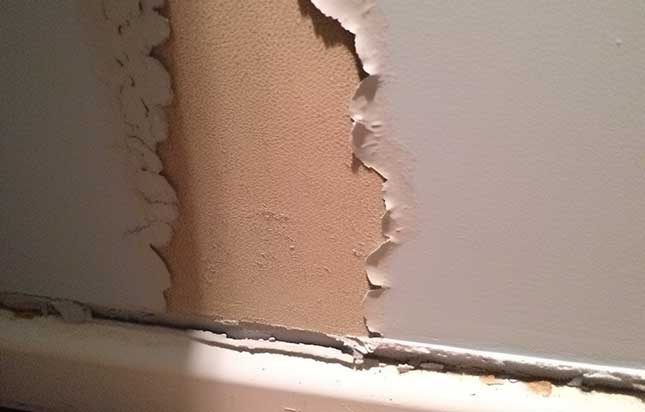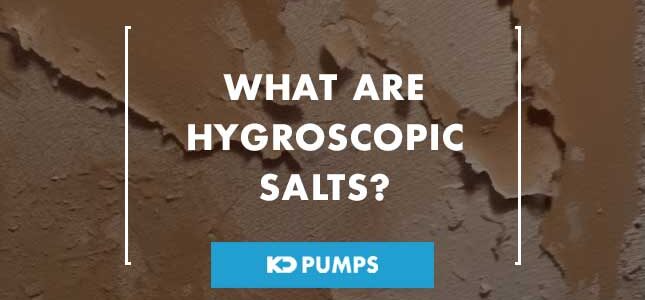What are Hygroscopic Salts?
Hygroscopic salts might sound like a term from a chemistry class, but their impact extends beyond the laboratory.
When talking about home maintenance, understanding hygroscopic salts is crucial for addressing potential issues that can affect the structural integrity and aesthetics of your home.
This article will cover exactly what hygroscopic salts are, their appearance in walls, the causes behind their presence, the damages they can inflict on a house, and methods for effective removal.
Article Chapters
What are Hygroscopic Salts?
Hygroscopic salts are compounds with a unique ability to absorb moisture from the surrounding environment.
Among them, nitrates and chlorides are particularly common.
Their presence is not confined to laboratory settings; rather, they are often integral components of construction materials.
When these materials encounter moisture, the hygroscopic salts within them dissolve, creating a damp solution.
This moisture-laden solution then migrates through porous building materials like bricks or plaster.
The consequences of this migration become visibly apparent on walls in the form of damp patches and crystalline salt deposits.
Understanding the science behind hygroscopic salts is fundamental to addressing issues related to dampness and salt deposits in buildings.
Their affinity for moisture can transform them from dormant components within construction materials to active agents causing aesthetic and structural concerns.
As this solution moves through porous surfaces, it carries dissolved salts, and when it reaches the surface and evaporates, it leaves behind these salts in the form of efflorescence—a visible indication of the migration of hygroscopic salts.
The impact of hygroscopic salts extends beyond mere visual disturbances.
The migration of these salts can contribute to dampness issues, compromising the integrity of building materials over time.
Therefore, recognizing the signs of hygroscopic salt-related problems is crucial for homeowners and property managers.
What do Hygroscopic Salts Look Like in Walls?

Hygroscopic salts leave salt deposits
Detecting hygroscopic salt problems in walls demands a keen eye for distinct visual indicators.
One of the primary telltale signs is the emergence of damp patches or dark areas on the wall surface.
These patches are evidence of moisture infiltration into the building material.
As the infiltrated moisture evaporates, it carries dissolved salts to the wall’s surface.
Upon evaporation, these salts crystallise, forming distinctive deposits.
These deposits can manifest as a powdery substance on the wall.
This visual phenomenon is commonly known as efflorescence.
Efflorescence is not merely an aesthetic concern; it serves as a visible marker for underlying issues related to moisture and hygroscopic salts.
It indicates that the salts, initially dormant within the construction material, have become active due to moisture exposure.
These deposits on the wall surface are a tangible representation of the migration of these salts through porous materials.
Moreover, efflorescence often suggests ongoing moisture-related challenges within the structure.
Persistent dampness can exacerbate the problem, leading to continuous salt migration and crystalline formations.
Therefore, addressing efflorescence involves not only removing the visible deposits but also investigating and rectifying the root cause of moisture infiltration.
Understanding the visual manifestation of hygroscopic salt activity is crucial for homeowners.
Recognising these damp patches and efflorescence early on can prompt timely interventions to mitigate the long-term impact of these salts on building materials and structural integrity.
By addressing both the visible signs and the underlying moisture dynamics, individuals can effectively manage hygroscopic salt issues in their walls.
What are the Causes of Hygroscopic Salts in the Home?
The presence of hygroscopic salts in homes is fundamentally linked to moisture.
Various causes contribute to this moisture intrusion, each requiring distinct remedies for effective mitigation.
Leaking Pipes

Leaky pipes can cause issues with hygroscopic salts
Undetected or unrepaired leaking pipes can introduce excess moisture into the building structure.
A sudden occurrence of low water pressure could be a clear sign you have a leaking pipe.
This moisture, laden with salts, can contribute to hygroscopic salt-related issues.
Addressing plumbing leaks promptly is essential to prevent continuous salt migration and associated damages.
Rising Damp
Rising damp is another common cause.
Groundwater, or inadequate drainage from waterlogged gardens, can ascend through walls, especially in structures without proper damp-proof courses.
As the water rises, it carries dissolved salts with it, leading to the formation of hygroscopic salt deposits on interior walls.
Inadequate Waterproofing
Homes with insufficient waterproofing measures are vulnerable to moisture penetration.
Rainwater or external groundwater can permeate through inadequately protected surfaces, introducing salts into the building materials.
Ensuring proper waterproofing is essential to mitigate hygroscopic salt issues.
Condensation
Excessive condensation, often due to poor ventilation, can lead to elevated moisture levels indoors.
The resulting dampness can foster the migration of salts within the building materials, exacerbating hygroscopic salt-related problems.
Construction Materials
The materials used in construction can contribute to salt-related issues.
If materials contain hygroscopic salts or are prone to absorbing moisture, it can initiate the process of salt migration.
Choosing construction materials carefully is vital for long-term mitigation.
What Damage can Hygroscopic Salts do to a House?
The impact of hygroscopic salts on a house can be significant, extending beyond the aesthetic concerns of salt deposits and damp patches.
These salts can compromise the structural integrity of building materials, leading to various forms of damage over time.
Degrading Mortar and Plaster

Hygroscopic salts can drastically affect plaster
Hygroscopic salts, when present in building materials, can contribute to the degradation of mortar and plaster.
The salts absorb moisture, causing these materials to weaken, crack, or crumble.
This compromises the stability and appearance of walls and surfaces.
Corrosion of Metal Elements
Metal elements within a building, such as structural supports, can be adversely affected by hygroscopic salts.
The salts promote corrosion, diminishing the strength and longevity of these crucial components.
Surface Crumbling and Spalling
Over time, the constant presence of moisture and salt can lead to the crumbling or spalling of surfaces.
This is particularly evident in areas where salt deposits accumulate, affecting both the interior and exterior of a structure.
Structural Compromises
In extreme cases, the prolonged impact of hygroscopic salts can compromise the stability of walls and structural elements.
This poses a serious risk to the overall safety and longevity of the building.
Impact on Interior Finishes
The presence of salt deposits can also impact interior finishes such as paint and wallpaper.
These materials can blister, peel, or discolour due to the underlying salt-related issues.
How can Hygroscopic Salts be Removed?
Addressing hygroscopic salts requires a systematic approach, involving both the elimination of the source of moisture and the treatment of visible salt deposits.
Here are comprehensive methods for effective removal:
Identifying and Eliminating Moisture Sources
The primary step in addressing hygroscopic salts is identifying and eliminating the source of moisture.
This involves a thorough inspection of the property to detect leaks, poor drainage, or rising damp.
Fixing these issues prevents the continuous introduction of moisture and salts into the building.
Improving Drainage
Adequate drainage is crucial for preventing water accumulation around the foundation.
Installing or enhancing drainage systems, such as gutters and downspouts, directs water away from the home, reducing the risk of moisture infiltration.
Fixing Leaks
Plumbing leaks contribute significantly to excess moisture.
Promptly fixing leaks in pipes, roofs, or windows is imperative.
This not only prevents further salt migration but also preserves the structural integrity of the building.
Installing Damp-Proofing Measures
Damp-proof courses or membranes can be installed to prevent the upward movement of moisture through walls.
These barriers inhibit the migration of salts, addressing the root cause of hygroscopic salt-related issues.
Brushing or Vacuuming Visible Deposits
Once the moisture source is addressed, visible salt deposits can be removed from surfaces using brushes or vacuums.
This method, while effective for surface-level cleaning, does not eliminate the salts within the building materials.
Professional Interventions
For a comprehensive solution, professional interventions may be necessary, such as using KD Pumps professional and effective services.
This can include the application of salt-inhibiting coatings on affected surfaces.
These coatings create a barrier that prevents the migration of salts to the surface.
Material Replacement
In severe cases where building materials are extensively damaged, replacement may be the most effective solution.
This involves removing and replacing affected plaster, mortar, or other compromised elements to ensure the structural integrity of the building.
Humidity Control
Maintaining indoor humidity at optimal levels can prevent the activation of hygroscopic salts.
Dehumidifiers or improved ventilation systems can be employed to regulate humidity, reducing the risk of salt-related issues.
Conclusion
Hygroscopic salts, though seemingly innocuous, can wreak havoc on the structural integrity and aesthetics of a home.
Recognising the signs, understanding the causes, and implementing effective removal methods are essential steps in maintaining a healthy and resilient living space.
Regular inspections and proactive measures against moisture intrusion are key to preventing the damaging effects of hygroscopic salts and ensuring the longevity of your home.
For any and all drainage needs, please get in touch with us here at KD Pumps.


Comments are closed.